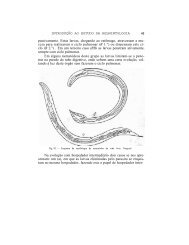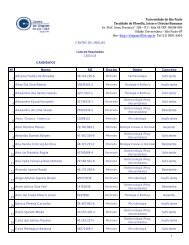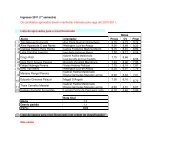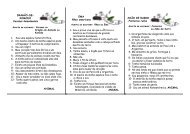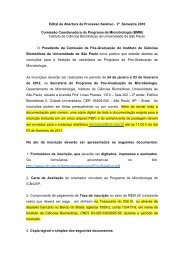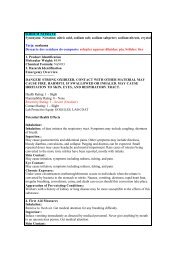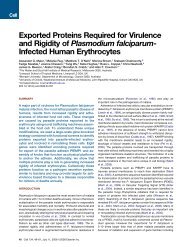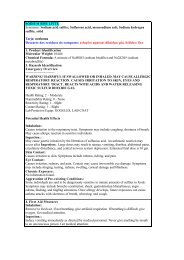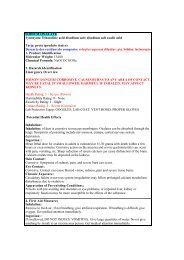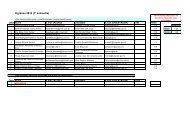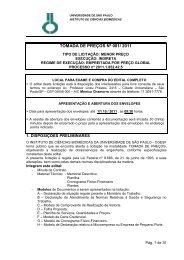chrome alum dodecahydrate - USP
chrome alum dodecahydrate - USP
chrome alum dodecahydrate - USP
Create successful ePaper yourself
Turn your PDF publications into a flip-book with our unique Google optimized e-Paper software.
CHROMIUM POTASSIUM SULPHATESynonyms : <strong>chrome</strong> <strong>alum</strong> <strong>dodecahydrate</strong>; sulfuric acid, chromium (3+) potassium salt(2:1:1) <strong>dodecahydrate</strong>; chromium potassium sulfate, 12-hydrateTarja: preta (potencialmente carcinogênico)Descarte dos resíduos do composto: Soluções aquosas diluídas: pia. Sólidos: coletaseparada.1. Product IdentificationMolecular Weight: 499.48Chemical Formula: CrK(SO4)2 12H2O3. Hazards IdentificationEmergency OverviewWARNING! HARMFUL IF SWALLOWED OR INHALED. CAUSES IRRITATIONTO SKIN, EYES AND RESPIRATORY TRACT.Health Rating: 2 - ModerateFlammability Rating: 0 - NoneReactivity Rating: 0 - NoneContact Rating: 1 - SlightLab Protective Equip: GOGGLES; LAB COATPotential Health EffectsInhalation::Causes irritation to the respiratory tract. Symptoms may include coughing, shortness of breath.May cause headache, dyspnea, and fever. May also cause tracheobronchial irritation andpulmonary edema.Ingestion::Causes irritation to the gastrointestinal tract. Large oral doses may cause dizziness intensethirst, abdominal pain, vomiting, and shock. Death may occur from renal failure. Chromiumcompounds in the 3+ state have a much lower toxicity than those in the 6+ state.Skin Contact:Causes irritation to skin. Symptoms include redness, itching, and pain. Prolonged contact maycause skin ulcerations.Eye Contact:Causes irritation, redness, and pain. Prolonged contact may cause eye damage.Chronic Exposure:Prolonged or repeated skin exposure may cause dermatitis. Prolonged or repeated Inhalation:of dust may cause perforation of the nasal septum.Aggravation of Pre-existing Conditions:Persons with pre-existing skin conditions or impaired respiratory function may be moresusceptible to the effects of this substance.4. First Aid MeasuresInhalation::Remove to fresh air. If not breathing, give artificial respiration. If breathing is difficult, giveoxygen. Get medical attention.Ingestion::Induce vomiting immediately as directed by medical personnel. Never give anything by mouth
to an unconscious person. Get medical attention.Skin Contact:Immediately flush skin with plenty of soap and water for at least 15 minutes. Removecontaminated Clothing and shoes. Get medical attention. Wash Clothing before reuse.Thoroughly clean shoes before reuse.Eye Contact:Immediately flush eyes with plenty of water for at least 15 minutes, lifting lower and uppereyelids occasionally. Get medical attention immediately.5. Fire Fighting MeasuresFire:Not considered to be a fire hazard.Explosion:Not considered to be an explosion hazard.Fire Extinguishing Media:Use any means suitable for extinguishing surrounding fire.Special Information:Use protective Clothing and breathing equipment appropriate for the surrounding fire.6. Accidental Release MeasuresVentilate area of leak or spill. Wear appropriate personal protective equipment as specified inSection 8. Spills: Sweep up and containerize for reclamation or disposal. Vacuuming or wetsweeping may be used to avoid dust dispersal. US Regulations (CERCLA) require reportingspills and releases to soil, water and air in excess of reportable quantities. The toll free numberfor the US Coast Guard National Response Center is (800) 424-8802.7. Handling: and StorageKeep in a tightly closed container, stored in a cool, dry, ventilated area. Protect againstphysical damage. Isolate from incompatible substances. Containers of this material may behazardous when empty since they retain product residues (dust, solids); observe all warningsand precautions listed for the product.8. Exposure Controls/Personal ProtectionAirborne Exposure Limits:-OSHA Permissible Exposure Limit (PEL):for Cr(III) compounds = 0.5mg/m3 (TWA)-ACGIH Threshold Limit Value (TLV):for Cr(III) compounds = 0.5 mg/m3 (TWA), A4 - Not classifiable as a human carcinogenVentilation System:A system of local and/or general exhaust is recommended to keep employee exposures belowthe Airborne Exposure Limits. Local exhaust ventilation is generally preferred because it cancontrol the emissions of the contaminant at its source, preventing dispersion of it into thegeneral work area. Please refer to the ACGIH document, Industrial Ventilation, A Manual ofRecommended Practices, most recent edition, for details.Personal Respirators (NIOSH Approved):If the exposure limit is exceeded, a half-face dust/mist respirator may be worn for up to tentimes the exposure limit or the maximum use concentration specified by the appropriateregulatory agency or respirator supplier, whichever is lowest. A full-face piece dust/mistrespirator may be worn up to 50 times the exposure limit, or the maximum use concentrationspecified by the appropriate regulatory agency, or respirator supplier, whichever is lowest. For
emergencies or instances where the exposure levels are not known, use a full-facepiecepositive-pressure, air-supplied respirator. WARNING: Air-purifying Respirators do notprotect workers in oxygen-deficient atmospheres.Skin Protection:Wear impervious protective Clothing, including boots, gloves, lab coat, apron or coveralls, asappropriate, to prevent skin contact.Eye Protection:Use chemical safety goggles and/or full face shield where dusting or splashing of solutions ispossible. Maintain eye wash fountain and quick-drench facilities in work area.9. Physical and Chemical PropertiesAppearance: Red-violet granules.Odor: Odorless.Specific Gravity: 1.83% Volatiles by volume @ 21C (70F): 0Melting Point: Loses water @ 89C ; Loses all water @ 400C (752F)10. Stability and ReactivityStability: Stable under ordinary conditions of use and Storage. Aqueous solution slowlybecomes green on heating and recovers reddish-violet colors on cooling.Hazardous Decomposition Products: Burning may produce sulfur oxides.Hazardous Polymerization: Will not occur.Incompatibilities: Aluminum and magnesium.Conditions to Avoid: Heat, flames, ignition sources and incompatibles.11. Toxicological InformationToxicological Data:Investigated as a tumorigen, mutagen.Carcinogenicity:ACGIH classification: Group A4 - Not classifiable as a human carcinogen.--------\Cancer Lists\---------------------------------------------------------NTP Carcinogen---Ingredient Known Anticipated IARC Category------------------------------------ ----- ----------- -------------Chromium Potassium Sulfate No No 3(10141-00-1)12. Ecological InformationEnvironmental Fate:When released into the soil, this material may leach into groundwater. When released intowater, this material is not expected to evaporate significantly. This material is not expected tosignificantly bioaccumulate. When released into the air, this material may be removed fromthe atmosphere to a moderate extent by wet deposition.Environmental Toxicity:No information found.



